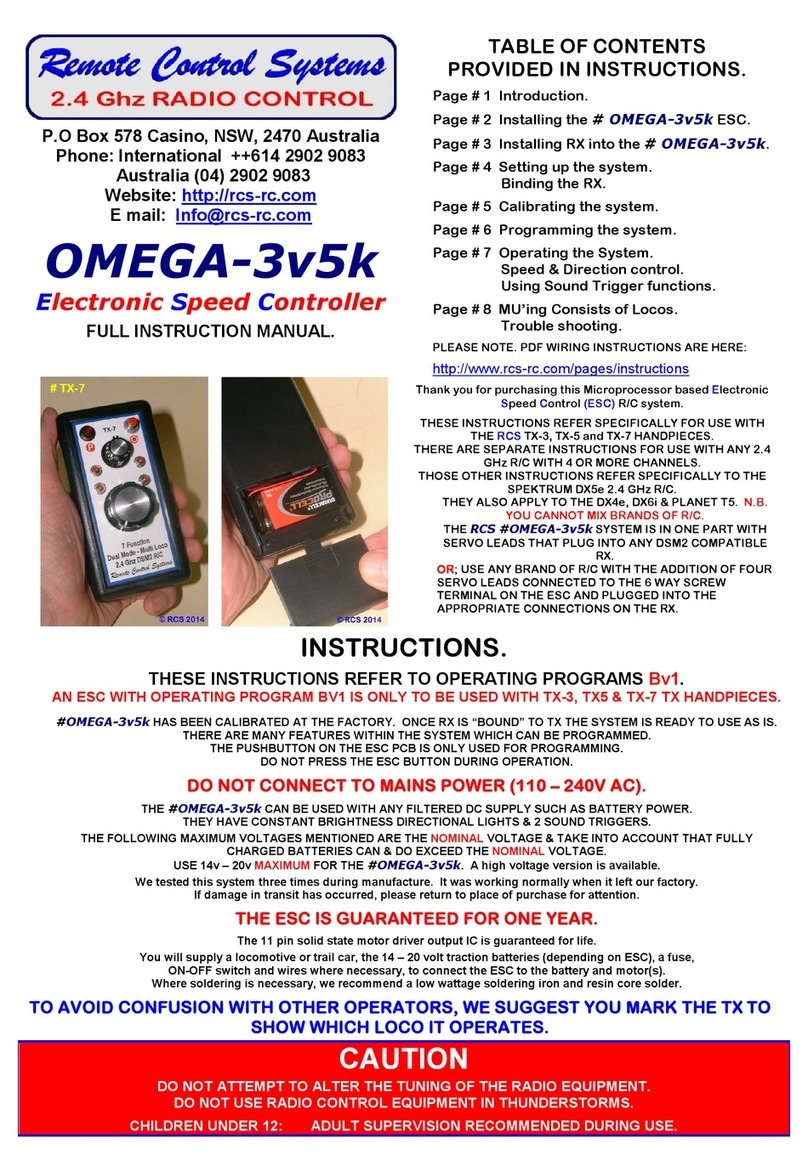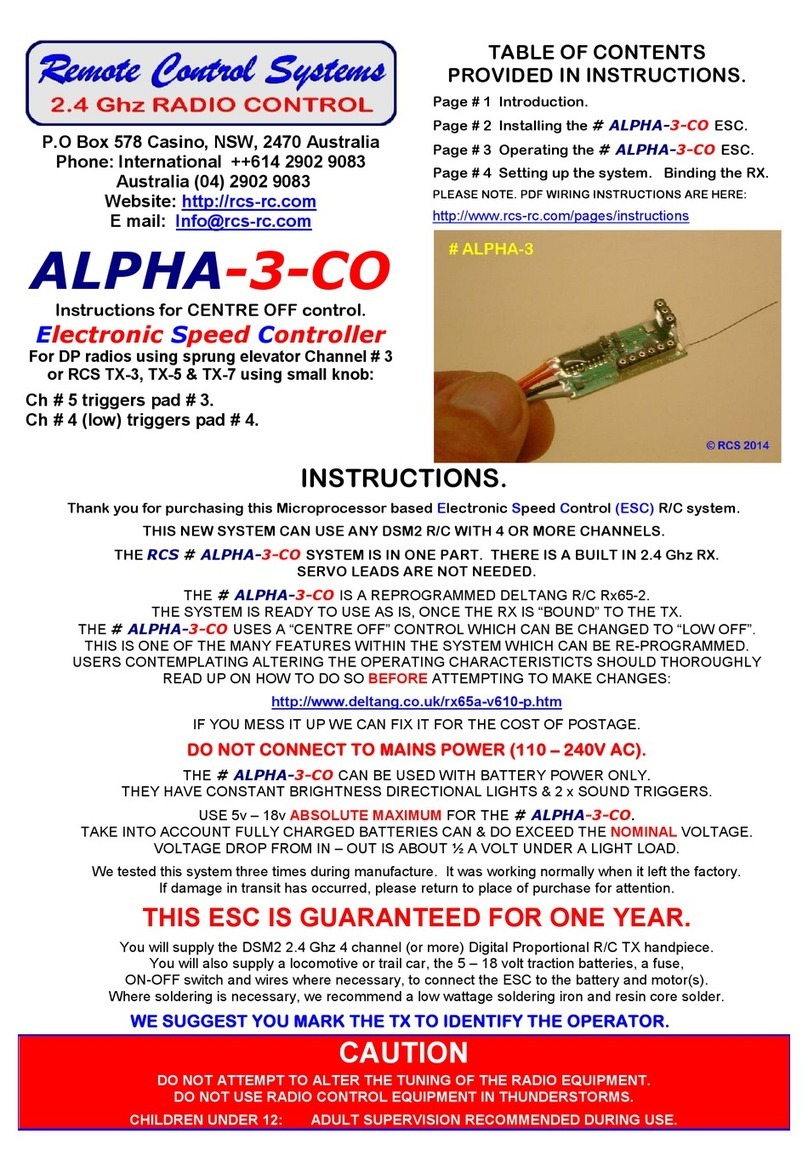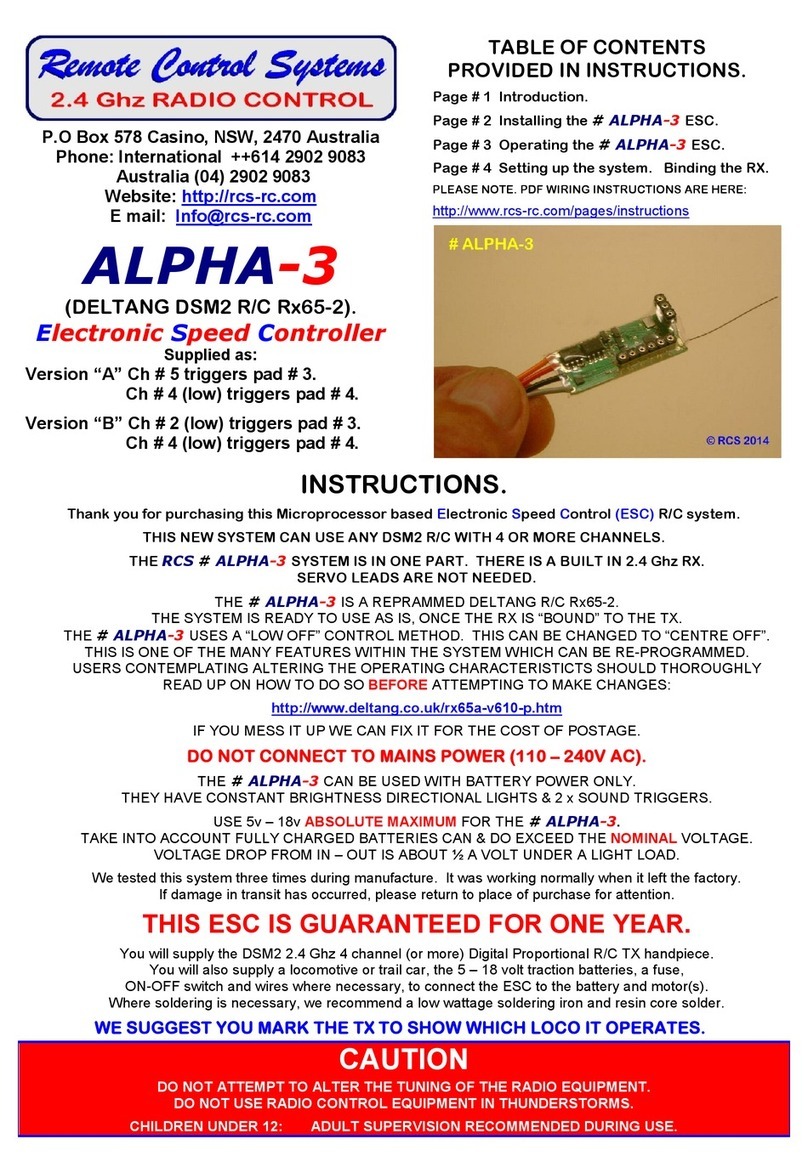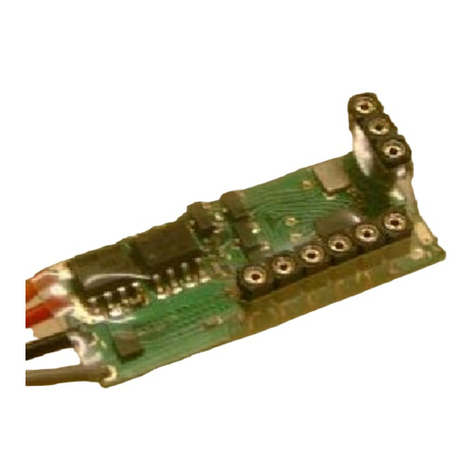
- 6 –
3. PROGRAMMING.
Operating features of the RCS-PRO system can be programmed from the TX using the supplied pushbutton.
Programming can only take place when the system is in neutral.
3.1 START VOLTAGE. This feature is designed to equalise the starting voltage of dissimilar locos.
3.2 TOP SPEED VOLTAGE. This can limit the top speed available. Either for speed matching locos or, for limiting the
top speed of one loco, say, when the system is being operated by children.
3.3 MOMENTUM. Toggle momentum control ON or OFF.
3.4 DEFAULT DIRECTION. Re-set the direction of a loco when it is to run back to back with another loco.
3.5 SYSTEM RESET. This takes # 1 & # 2 back to the factory default if incorrectly set.
3.6/7/8/9 SET SOUND TRIGGERS 1, 2, 3 & 4 from MOM (Default) to Latch ON - OFF.
HOW TO USE THE PROGRAMMING FEATURE.
Turn the TX & Loco ON. The RX & loco lights will stay OFF until the TX & RX are linked. Then blink 3 x times & go solid
ON. The system will then be, & must stay, in neutral. Or, if you have been running, return to neutral before programming.
Then press the supplied pushbutton once & the lights will go out. The system is now in Programming Mode.
SPEED MATCHING.
If you have two or more locos that have dissimilar starting and top speeds, you can adjust those voltages so the locos will
be fairly accurately speed matched across the speed range. It has been our experience that absolutely accurate
matching is not really needed for smooth performance. The trade off is, the top speed of a consist of locos controlled by
one TX will be limited to the top speed of the slowest loco.
3.1 START VOLTAGE. We suggest you test the locos you wish to match one at a time to find out the stick setting at
which the slowest starting locos begin to move. Count the number of clicks on the throttle stick from OFF (down).
Then, with the slowest loco stopped and the direction set to neutral:
Move the throttle stick to the loco start speed desired. i.e. to the stick position where the loco started moving.
Then push the direction (elevator) stick forwards once only. The lights will blink ONCE with the push.
Wait a couple of seconds for the lights to blink ONCE again indicating the new start voltage setting has been stored in the
system memory. Then move the throttle stick back to zero (OFF) position. i.e. stick down.
Then press and release the pushbutton. The lights will blink three times and then go to all solid ON. i.e. Neutral.
Repeat the procedure if the setting is incorrect.
3.2 TOP SPEED VOLTAGE. If speed matching, we suggest you test the locos you wish to match one at a time to find
out the stick setting at which the fastest loco matches the top speed of the slowest loco.
Then, with the fastest loco stopped and the direction set to neutral:
Move the throttle stick to the lower top speed desired for the loco. i.e. to the stick position where the fastest loco matched
the top speed of the slowest loco.
Then push the direction (elevator) stick forwards TWICE only. The lights will blink once with each push.
Wait a couple of seconds for the lights to blink TWICE again indicating the new top speed voltage setting has been stored
in the system memory. Then move the throttle stick back to zero (OFF) position. i.e. stick down.
Then press and release the pushbutton. The lights will blink three times and then go to all solid ON. i.e. Neutral.
Repeat the procedure if the setting is incorrect.
OR: When children are using the loco, you can follow the same steps to limit the top speed of any loco.
3.3 MOMENTUM. Toggle momentum control ON or OFF.
Press the elevator stick forwards THREE times only. The lights will blink once with each push.
Wait a couple of seconds for the lights to blink THREE times again indicating the default momentum ON – OFF setting
has been stored in the system memory.
Then press and release the pushbutton. The lights will blink three times and then go to all solid ON. i.e. Neutral.
3.4 DEFAULT DIRECTION. To re-set the default direction of a loco to run back to back with another loco:
Push the direction (elevator) stick forwards FOUR times only. The lights will blink once with each push.
Wait a couple of seconds for the lights to blink FOUR times again indicating the default direction setting has been stored
in the system memory.
Then press and release the pushbutton. The lights will blink three times and then go to all solid ON. i.e. Neutral.
3.5 SYSTEM RESET. To take # 3.1 & # 3.2 back to the factory default if incorrectly set:
Push the direction (elevator) stick forwards FIVE times only. The lights will blink once with each push.
Wait a couple of seconds for the lights to blink FIVE times again indicating the start & top speed voltage settings have
been returned to default in the system memory.
Then press and release the pushbutton. The lights will blink three times and then go to all solid ON. i.e. Neutral.
3. 6/7/8/9 SET SOUND TRIGGERS F1, F2, F3 & F4 from MOM (Default) to Latch ON - OFF.
For trigger # 1 Push the direction (elevator) stick forwards SIX times only. The lights will blink once with each push.
Wait a couple of seconds for the lights to blink SIX times again, indicating the trigger has toggled to latch ON-OFF.
Then press and release the pushbutton. The lights will blink three times and then go to all solid ON. i.e. Neutral.
Repeat procedure for trigger #2(SEVEN pushes), trigger # 3 (EIGHT pushes) & trigger # 4 (NINE pushes).
Repeat procedure to change any of these 3 x triggers back to MOMENTARY from Latch ON – OFF.






























